Snub square tiling
| Snub square tiling | |
|---|---|
 | |
| Type | Semiregular tiling
|
| Vertex configuration | 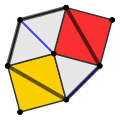 3.3.4.3.4 |
| Schläfli symbol | s{4,4} sr{4,4} or |
| Wythoff symbol | | 4 4 2 |
| Coxeter diagram | |
| Symmetry | p4g , [4+,4], (4*2)
|
| Rotation symmetry | p4 , [4,4]+, (442)
|
| Bowers acronym | Snasquat |
| Dual | Cairo pentagonal tiling |
| Properties | Vertex-transitive
|
In
Conway calls it a snub quadrille, constructed by a snub operation applied to a square tiling (quadrille).
There are 3
Uniform colorings
There are two distinct uniform colorings of a snub square tiling. (Naming the colors by indices around a vertex (3.3.4.3.4): 11212, 11213.)
| Coloring |  11212 |
 11213 |
|---|---|---|
| Symmetry | 4*2, [4+,4], (p4g) | 442, [4,4]+, (p4) |
| Schläfli symbol | s{4,4} | sr{4,4} |
| Wythoff symbol | | 4 4 2 | |
Coxeter diagram
|
Circle packing
The snub square tiling can be used as a circle packing, placing equal diameter circles at the center of every point. Every circle is in contact with 5 other circles in the packing (kissing number).[1]
Wythoff construction
The snub square tiling can be constructed as a snub operation from the square tiling, or as an alternate truncation from the truncated square tiling.
An alternate truncation deletes every other vertex, creating a new triangular faces at the removed vertices, and reduces the original faces to half as many sides. In this case starting with a truncated square tiling with 2
If the original tiling is made of regular faces the new triangles will be isosceles. Starting with octagons which alternate long and short edge lengths, derived from a regular dodecagon, will produce a snub tiling with perfect equilateral triangle faces.
Example:
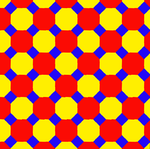 Regular octagons alternately truncated |
→ (Alternatetruncation) |
 Isosceles triangles (Nonuniform tiling) |
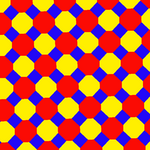 Nonregular octagons alternately truncated |
→ (Alternatetruncation) |
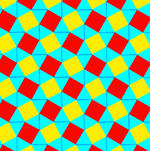 Equilateral triangles |
Related tilings
-
Asnub operatorapplied twice to the square tiling, while it doesn't have regular faces, is made of square with irregular triangles and pentagons.
-
A relatedisogonal tilingthat combines pairs of triangles into rhombi
-
A 2-isogonal tiling can be made by combining 2 squares and 3 triangles into heptagons.
-
The Cairo pentagonal tiling is dual to the snub square tiling.
Related k-uniform tilings
This tiling is related to the
| Related tilings of triangles and squares | ||||||
|---|---|---|---|---|---|---|
| snub square | elongated triangular | 2-uniform | 3-uniform | |||
| p4g, (4*2) | p2, (2222) | p2, (2222) | cmm, (2*22) | p2, (2222) | ||
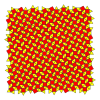 [32434] |
 [3342] |
 [3342; 32434] |
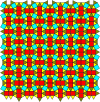 [3342; 32434] |
 [2: 3342; 32434] |
 [3342; 2: 32434] | |
Related topological series of polyhedra and tiling
The snub square tiling is third in a series of snub polyhedra and tilings with vertex figure 3.3.4.3.n.
| 4n2 symmetry mutations of snub tilings: 3.3.4.3.n | ||||||||
|---|---|---|---|---|---|---|---|---|
| Symmetry 4n2 |
Spherical | Euclidean | Compact hyperbolic | Paracomp. | ||||
| 242 | 342 | 442 | 542 | 642 | 742 | 842 | ∞42 | |
| Snub figures |

|

|

|

|

|

|

|

|
| Config. | 3.3.4.3.2 | 3.3.4.3.3 | 3.3.4.3.4 | 3.3.4.3.5 | 3.3.4.3.6 | 3.3.4.3.7 | 3.3.4.3.8 | 3.3.4.3.∞
|
| Gyro figures |

|

|

|

|
||||
Config.
|
V3.3.4.3.2 | V3.3.4.3.3 | V3.3.4.3.4 | V3.3.4.3.5
|
V3.3.4.3.6 | V3.3.4.3.7 | V3.3.4.3.8 | V3.3.4.3.∞ |
The snub square tiling is third in a series of snub polyhedra and tilings with vertex figure 3.3.n.3.n.
| 4n2 symmetry mutations of snub tilings: 3.3.n.3.n | |||||||||||
|---|---|---|---|---|---|---|---|---|---|---|---|
| Symmetry 4n2 |
Spherical | Euclidean | Compact hyperbolic | Paracompact | |||||||
| 222 | 322 | 442 | 552 | 662 | 772 | 882 | ∞∞2 | ||||
| Snub figures |

|

|

|

|

|

|

|

| |||
| Config. | 3.3.2.3.2 | 3.3.3.3.3
|
3.3.4.3.4 | 3.3.5.3.5 | 3.3.6.3.6 | 3.3.7.3.7 | 3.3.8.3.8 | 3.3.∞.3.∞ | |||
| Gyro figures |

|

|

|

| |||||||
Config.
|
V3.3.2.3.2 | V3.3.3.3.3
|
V3.3.4.3.4 | V3.3.5.3.5 | V3.3.6.3.6 | V3.3.7.3.7 | V3.3.8.3.8 | V3.3.∞.3.∞ | |||
| Uniform tilings based on square tiling symmetry | |||||||||||
|---|---|---|---|---|---|---|---|---|---|---|---|
| Symmetry: [4,4], (*442) | [4,4]+, (442) | [4,4+], (4*2) | |||||||||

|

|

|

|

|

|

|

| ||||
| {4,4} | t{4,4} | r{4,4} | t{4,4} | {4,4} | rr{4,4} | tr{4,4} | sr{4,4} | s{4,4} | |||
| Uniform duals | |||||||||||

|

|

|

|

|

|

|

| ||||
| V4.4.4.4 | V4.8.8 | V4.4.4.4 | V4.8.8 | V4.4.4.4 | V4.4.4.4 | V4.8.8 | V3.3.4.3.4 | ||||
See also
- List of uniform planar tilings
- Snub (geometry)
- Snub square prismatic honeycomb
- Tilings of regular polygons
- Elongated triangular tiling
References
- ^ Order in Space: A design source book, Keith Critchlow, p.74-75, circle pattern C
- .
- ^ "Uniform Tilings". Archived from the original on 2006-09-09. Retrieved 2006-09-09.
- John H. Conway, Heidi Burgiel, Chaim Goodman-Strauss, The Symmetries of Things 2008, ISBN 978-1-56881-220-5 [1]
- Klitzing, Richard. "2D Euclidean tilings s4s4s - snasquat - O10".
- ISBN 0-7167-1193-1. (Chapter 2.1: Regular and uniform tilings, p. 58-65)
- ISBN 0-486-23729-X. p38
- Dale Seymour and ISBN 978-0866514613, pp. 50–56, dual p. 115








